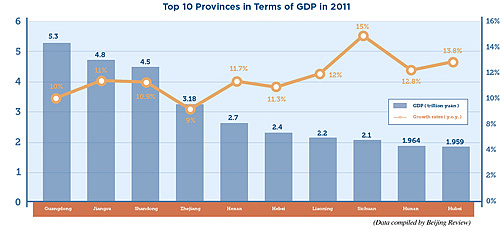|
Mei Xinyu, an associate research fellow with the Chinese Academy of International Trade and Economic Cooperation at the Ministry of Commerce, said it is necessary to take a rational approach to the GDP figures. "Per-capita GDP is not equal to per-capita wealth," he said.
For example, the per-capita disposal income of Beijing residents was 32,900 yuan ($5,197) in 2011, about one third of the capital city's per-capita GDP. But its consumer price index, a barometer of inflation went up 5.6 percent. Housing prices in the city averaged at least 13,000 yuan ($2,054) per square meter. In other words, the annual income of a local resident is lower than the price of a living space of 3 square meters. That means China still lags far behind developed nations in terms of residents' livelihoods.
Moreover, provincial per-capita GDP data are usually affected by population figures. If the mobile population and the permanent population who are not registered as local residents are factored in, the per-capita GDP would shrink.
The Chinese economy has been slowing down in the past two years, and that trend may continue this year. As a result, worries abound that the policies of regional economic balance could be impacted.
Zhang Xiang, Executive Vice President of the China Center for International Economic Exchanges, downplayed the worries, saying that the Central Government has attached priority importance to regional economic development in the 12th Five-year Plan (2011-15).
"But the challenge is how to make full use of the advantages of various regions and sustain the growth momentum," said Zhang.
Since the late 1990s the country has launched national campaigns to develop the western and central regions, as well as the northeast industrial bases. In recent years, the country has established many new development zones, including the Tianjin Binhai New Area and the Fujian Economic Zone on the west bank of the Taiwan Straits.
"Those programs have a common focus—to accelerate economic development by making full use of unique geographic resources and traditionally advantageous industries," he said.
Zhang added that many regions have established economic zones, encouraged by favorable policies of the Central Government. "That is a correct and necessary measure to prop up regional economies. But those regions should explore their development models with local characteristics, and also drive up the growth of neighboring areas," said Zhang. "That is the only way to ensure the sustainable dynamism of regional economies."
But one emerging problem is that some regions took protectionist measures to protect local enterprises. "The right altitude is to open up local markets and encourage healthy competition," he said.
The coastal cities have established a successful development model characterized by open economies. The central, western and northeastern regions should learn from their experiences and embark on a sustainable path of regional economic development.
The northeastern regions have the best opportunities among all economic regions of China, said Zhang.
They enjoy geographic advantages to develop open economies due to their proximity to Russia and the Pacific Ocean.
Russia's entry into the World Trade Organization will help draw 93 percent of the global trade into this organization. Meanwhile, China, Japan and South Korea are going to initiate talks to build a free trade zone. "All this will bring about structural changes in east Asia's international markets," he said.
"That presents a good opportunity for the growth of China's northeastern regions, and this should be a major bright spot on the landscape of the country's balanced regional economic development," he added.

Email us at: lanxinzhen@bjreview.com | 